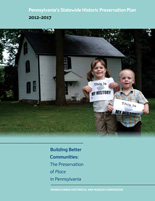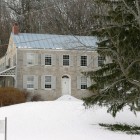As the Commonwealth’s State Historic Preservation Office, the Pennsylvania Historical and Museum Commission’s Bureau for Historic Preservation (BHP) is responsible for partnering with all the citizens of Pennsylvania to advocate for the protection of the Commonwealth’s natural and cultural heritage. To do this, the Bureau for Historic Preservation (BHP) develops a statewide strategic plan every five years that lays out goals and actions steps that will guide our priorities over the next five years. It’s a big job to develop and implement this plan, because, as you know, Pennsylvania is a very big and historic place. To preserve and protect our important history, we need everyone to pitch in. And, this is why I’m sending you this inaugural message about BHP’s latest effort to improve our communication with all of you! I’m hoping that you will be receptive to our messages and that we will hear back from you!
First of all, if you are not already familiar with it, we encourage you to read the 2012-2017 statewide historic preservation plan, Building Better Communities: The Preservation of Place in Pennsylvania.
 You can download a copy of this publication here.
You can download a copy of this publication here.
This plan sets a new direction for historic preservation by focusing on the relationship between the preservation of the Commonwealth’s archaeological and historic resources and the conservation of agricultural lands, natural resources, traditional communities, and recreational assets and how these important resources work together to create “a sense of place” that makes Pennsylvania so special to all of us who love its beauty and heritage. The five major goals of the plan are:
- Increase preservation planning at the local level by assisting communities to recognize, prioritize and capitalize on the benefits of preservation;
- Expand and strengthen state and federal partnerships to grow Pennsylvania’s economy by connecting historic preservation with economic development and natural resource conservation;
- Bolster the efforts of preservation advocates and partners to advance local, regional, and statewide preservation;
- Identify, recruit and engage new audiences to raise awareness and promote broad support for the preservation of the Commonwealth’s heritage as a part of the statewide strategy for growth and vitality; and,
- Administer an effective and proactive statewide historic preservation program that addresses preservation issues confronting Pennsylvania’s communities.
We set these priorities because Building Better Communities is the result of collaboration between BHP and the citizens of Pennsylvania. It was developed with extensive public input and diverse expertise from state and local government agencies and organizations. In our public forums, the terms appreciate, value, community authenticity and collaboration were heard over and over again. We also heard that historic preservation should not be defined and/or confined by bureaucratic perceptions, but promoted as an integral tool in the community revitalization toolbox. In our advocacy efforts to promote the benefits of historic preservation, we need to advance the understanding that historic preservation is essential to the mix of strategies that can help Pennsylvania grow and retain and attract residents, businesses and visitors. We hope everyone will learn more about Pennsylvania’s history, recognize its importance, and promote how it can, when balanced with other needs, improve and sustain the quality of life in the Commonwealth for the benefit of current and future generations.
While BHP is the leader and catalyst for implementing the Plan, it was created for all Pennsylvanians. With your full participation, our preservation efforts will be successful. To that end, with this note from me, BHP is launching a new communications effort that more fully employs various forms of electronic and social media. We want to “make new friends while keeping the old,” by communicating proactively about the agency’s programs and interests, dispelling myths and misunderstandings about what BHP does and does not do, and, most importantly, receive your reactions to what we are doing and learn more about your preservation values, issues and concerns.
From my twelve years service as Director of the Bureau for Historic Preservation, I believe that most citizens and elected officials are generally unaware of the breadth and depth of BHP’s expertise and the way our programs intersect and overlap with community revitalization, economic development, tourism and quality of life issues. In our new weekly blog, we’ll be talking about our diverse work. Some of the early topics that will be introduced include the agricultural trail of history markers at the annual Farm Show in Harrisburg, our new Agricultural Region Map, a recap of the photographic exhibit of mid-century modern architecture at the University of Pennsylvania Architectural Archives, and what archeology has revealed to us about the founding of Pandenarium.
BHP is invested in preserving, protecting and promoting the Commonwealth’s heritage. With your involvement, we believe we can guarantee a good return that will benefit the value of the Commonwealth’s diverse historic assets. Together, we need to encourage the Commonwealth to invest in traditional central business districts and neighborhoods, to coordinate heritage tourism efforts and to strengthen and apply existing historic preservation programs. If properly implemented, such measures will pay dividends to the Commonwealth not only in aesthetic, cultural, and historic terms, but also as it relates to job creation, economic activity, municipal revenues and real estate conditions.
Please make stewardship of Pennsylvania’s heritage a personal commitment and priority. All of the BHP’s staff welcome your participation!
Comment Policy
PHMC welcomes and encourages topic-related comments on this blog. PHMC reserves the right to remove comments that in PHMC’s discretion do not follow participation guidelines.
Commenters and Comments shall be related to the blog post topic and respectful of others who use this site.
Commenters and Comments shall not: use language that is offensive, inflammatory or provocative (this includes, but is not limited to, using profanity, obscene, or vulgar comments); disparage other commenters or people; condone illegal activity; identify the location of known or suspected archeological sites; post personal information in comments such as addresses, phone numbers, e-mail addresses or other contact details, which may relate to you or other individuals; impersonate or falsely claim to represent a person or an organization; make any commercial endorsement or promotion of any product, service or publication.
If you would like to comment on other topics not related to this blog post but related to PHMC, please fill out the PHMC Contact Us Form.

Leave a Reply